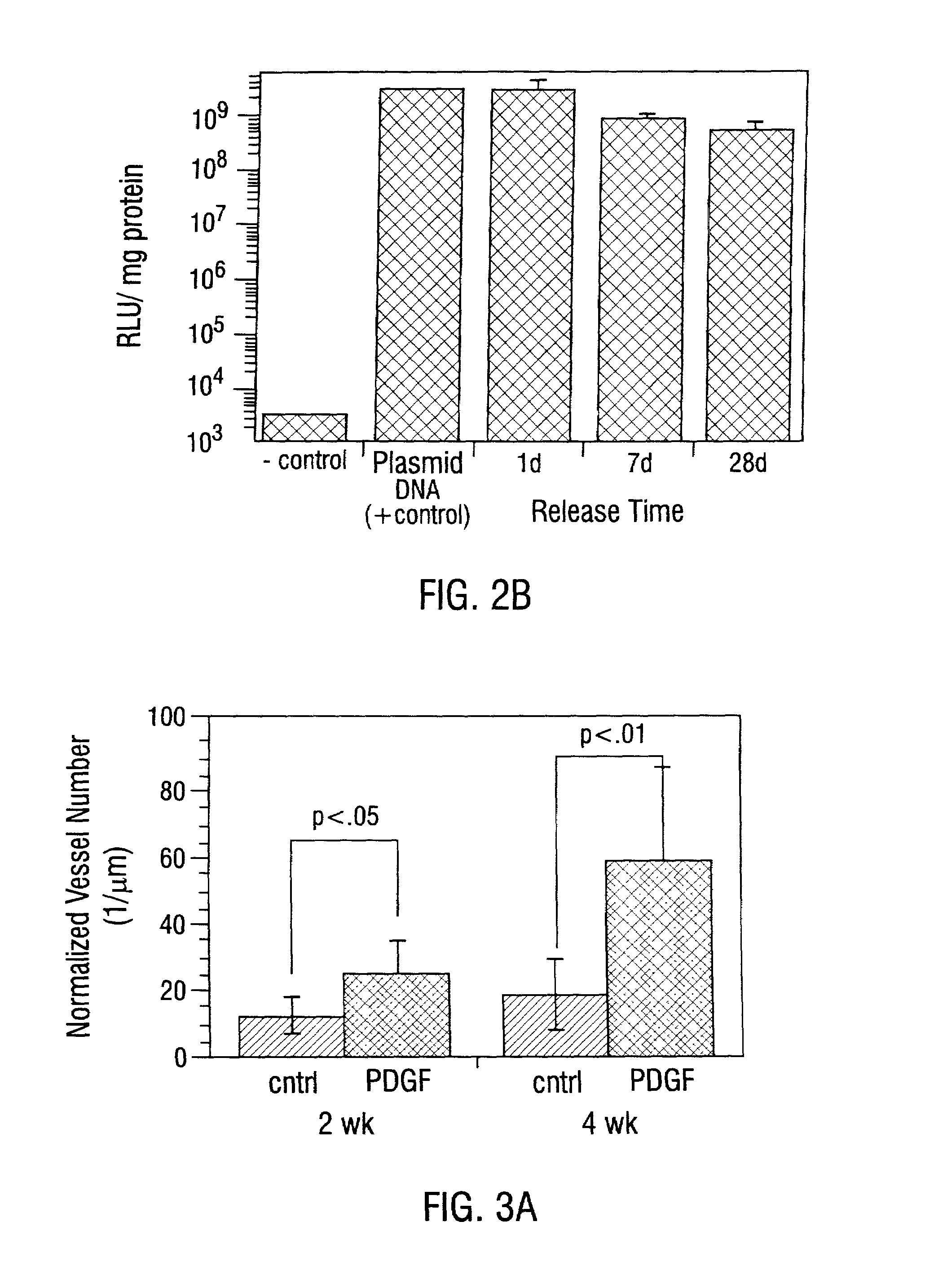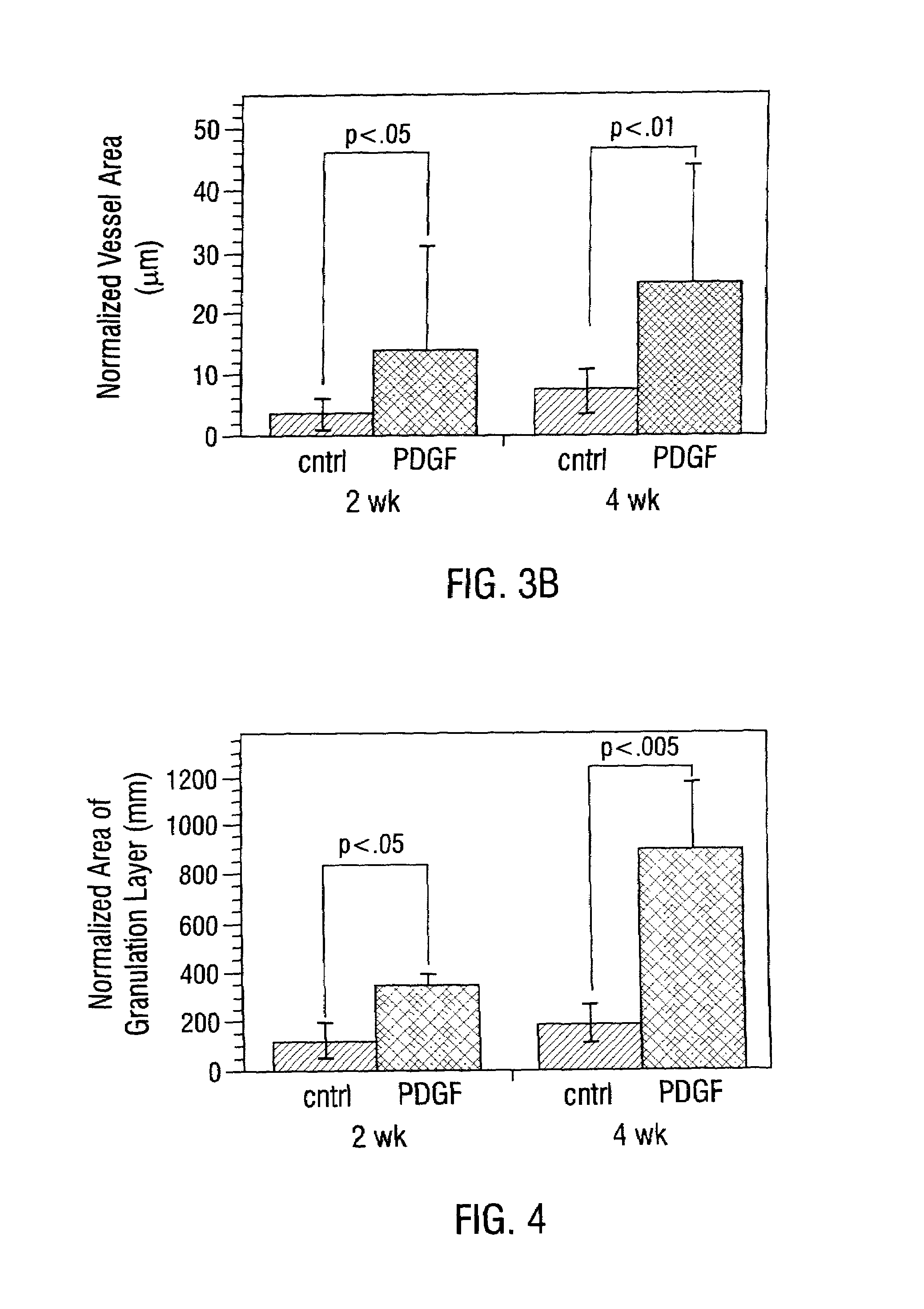Sustained DNA delivery from structural matrices
a structural matrix and dna technology, applied in the field of porous polymer materials, can solve the problems of loss or deficiency of tissue function, millions of surgical procedures each year, loss of hundreds of billions of dollars in western economies, and current techniques each suffer from their own drawbacks
- Summary
- Abstract
- Description
- Claims
- Application Information
AI Technical Summary
Benefits of technology
Problems solved by technology
Method used
Image
Examples
example i
Animal Model of Wound Repair in Terms of New Bone Formation
[0385]To study the effects of nucleic acid transfer on wound repair in terms of new bone formation, one of the inventors developed the following animal model osteotomy system. The rat osteotomy model protocol is generally completed in 25-35 minutes. The osteotomy is generally performed on one femur per animal. Right to left differences have not been apparent, but such differences are monitored in these studies, since the limb receiving the osteotomy is randomized.
[0386]After pre-operative preparation (i.e. shaving and betadine scrub), adult male Sprague Dawley rats (˜500 gm, retired male breeders) are anesthetized using a 3% halothane 97% oxygen mixture (700 ml / min. flow rate). A lateral approach to the femur is made on one limb. Utilizing specially designed surgical guides, four 1.2 mm diameter pins are screwed into the diaphysis after pre-drilling with a high speed precision bit. A surgical template ensures precise and par...
example ii
Mechanical Properties of New Bone Formation
[0394]The mechanical properties of new bone formed during gene transfer are measured using, e.g., whole bone torsion tests that create a stress state in which the maximum tensile stresses occur on planes that lie obliquely to the bone's longitudinal axis. Such tests may provide important inferences about the mechanical anisotropy of callus tissue and the degree of osseous integration of new bone tissue. These tests are particularly advantageous in the evaluation of fracture specimens, e.g., the irregular shape of callus tissue typically precludes the use of whole bone 4-point bending tests because it is difficult to reproducibly align the points from specimen to specimen.
[0395]Femurs are tested on an MTS Servohydraulic Testing Machine while moist and at room temperature. A torque sensor and rotary variable displacement transducer provides data for torque-angular displacement curves. Specially designed fixtures support each bone near the met...
example iii
Gene Constructs
[0397]Numerous genes, preferably mammalian or human genes, may be used as wound-healing or osteogenic genes for use in the matrix-gene transfer technology of the present invention. U.S. application Ser. No. 08 / 199,780, filed Feb. 18, 1994, now U.S. Pat. No. 5,763,416, is incorporated herein by reference for purposes including incorporating the text concerning the preparation and use of the active fragment of the human parathyroid hormone gene (hPTH1-34), expression vectors containing the hPTH1-34 gene and the use of the hPTH1-34 gene in gene transfer to promote wound-healing, as exemplified by new bone formation. Hendy et al. (1981) is also incorporated herein by reference for purposes including describing the DNA and amino acid sequences of hPTH1-34.
[0398]U.S. application Ser. No. 08 / 199,780, now U.S. Pat. No. 5,763,416, is also incorporated herein by reference for purposes including incorporating the text concerning the preparation and use of the mouse bone morphoge...
PUM
| Property | Measurement | Unit |
|---|---|---|
| size | aaaaa | aaaaa |
| pressure | aaaaa | aaaaa |
| porosity | aaaaa | aaaaa |
Abstract
Description
Claims
Application Information
 Login to View More
Login to View More - R&D
- Intellectual Property
- Life Sciences
- Materials
- Tech Scout
- Unparalleled Data Quality
- Higher Quality Content
- 60% Fewer Hallucinations
Browse by: Latest US Patents, China's latest patents, Technical Efficacy Thesaurus, Application Domain, Technology Topic, Popular Technical Reports.
© 2025 PatSnap. All rights reserved.Legal|Privacy policy|Modern Slavery Act Transparency Statement|Sitemap|About US| Contact US: help@patsnap.com



